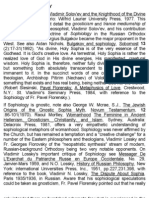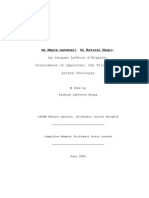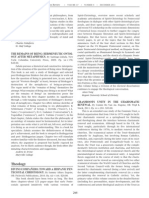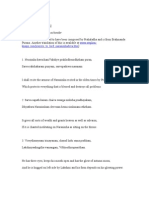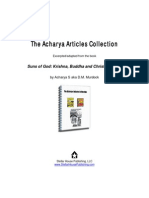0 ratings0% found this document useful (0 votes)
77 viewsDivine Scapegoats
Divine Scapegoats
Uploaded by
IlVitalThis document contains summaries of two books on religious studies:
1) Philosophical Theology, Volume Three by Robert Cummings Neville presents a plausible sacred worldview for religious participation as the concluding volume in a trilogy advancing a systematic philosophical theology.
2) Demonic Mimesis in Early Jewish Mysticism by Andrei A. Orlov explores the paradoxical symmetry between the divine and demonic in early Jewish mystical texts, focusing on how antagonists mirror angelic and divine features through mimetic imagery in two Slavonic pseudepigrapha works.
Copyright:
© All Rights Reserved
Available Formats
Download as PDF, TXT or read online from Scribd
Divine Scapegoats
Divine Scapegoats
Uploaded by
IlVital0 ratings0% found this document useful (0 votes)
77 views1 pageThis document contains summaries of two books on religious studies:
1) Philosophical Theology, Volume Three by Robert Cummings Neville presents a plausible sacred worldview for religious participation as the concluding volume in a trilogy advancing a systematic philosophical theology.
2) Demonic Mimesis in Early Jewish Mysticism by Andrei A. Orlov explores the paradoxical symmetry between the divine and demonic in early Jewish mystical texts, focusing on how antagonists mirror angelic and divine features through mimetic imagery in two Slavonic pseudepigrapha works.
Original Description:
Divine Scapegoats
Copyright
© © All Rights Reserved
Available Formats
PDF, TXT or read online from Scribd
Share this document
Did you find this document useful?
Is this content inappropriate?
This document contains summaries of two books on religious studies:
1) Philosophical Theology, Volume Three by Robert Cummings Neville presents a plausible sacred worldview for religious participation as the concluding volume in a trilogy advancing a systematic philosophical theology.
2) Demonic Mimesis in Early Jewish Mysticism by Andrei A. Orlov explores the paradoxical symmetry between the divine and demonic in early Jewish mystical texts, focusing on how antagonists mirror angelic and divine features through mimetic imagery in two Slavonic pseudepigrapha works.
Copyright:
© All Rights Reserved
Available Formats
Download as PDF, TXT or read online from Scribd
Download as pdf or txt
0 ratings0% found this document useful (0 votes)
77 views1 pageDivine Scapegoats
Divine Scapegoats
Uploaded by
IlVitalThis document contains summaries of two books on religious studies:
1) Philosophical Theology, Volume Three by Robert Cummings Neville presents a plausible sacred worldview for religious participation as the concluding volume in a trilogy advancing a systematic philosophical theology.
2) Demonic Mimesis in Early Jewish Mysticism by Andrei A. Orlov explores the paradoxical symmetry between the divine and demonic in early Jewish mystical texts, focusing on how antagonists mirror angelic and divine features through mimetic imagery in two Slavonic pseudepigrapha works.
Copyright:
© All Rights Reserved
Available Formats
Download as PDF, TXT or read online from Scribd
Download as pdf or txt
You are on page 1of 1
religious studies
Religion
Divine Scapegoats
Philosophical Theology,
Volume Three
Robert Cummings Neville
Demonic Mimesis
in Early Jewish Mysticism
Andrei A. Orlov
The concluding volume in a trilogy
advancing a systematic philosophical
theology, this book presents
a plausible sacred worldview for
religious participation.
Explores the paradoxical
symmetry between the divine
and demonic in early Jewish
mystical texts.
Through the development of philosophical theology, Neville has
built a unique, multidisciplinary, comparative, nonconfessional
theological system, one that addresses concerns and provides
tools for scientific and humanistic scholars of religion,
postmodern thinkers, intellectuals from both secular and
religious backgrounds, and those interested in the global state
of religion today.
Robert Cummings Neville is Professor of Philosophy,
Religion, and Theology and Dean Emeritus of the School of
Theology at Boston University. He is the author of many books,
including Ultimates: Philosophical Theology,Volume One; Existence:
Philosophical Theology,Volume Two; and Religion in Late Modernity,
all published by SUNY Press.
February 416 pp
$100.00 hc 978-1-4384-5699-7
$200.00 hc set of all three volumes 978-1-4384-5711-6
Divine Scapegoats is a wideranging exploration of
the parallels between the
heavenly and the demonic
in early Jewish apocalyptical
accounts. In these materials, antagonists often mirror features
of angelic figures, and even those of the Deity himself, an
inverse correspondence that implies a belief that the demonic
realm is maintained by imitating divine reality. Andrei A. Orlov
examines the sacerdotal, messianic, and creational aspects of
this mimetic imagery, focusing primarily on two texts from
the Slavonic pseudepigrapha: 2 Enoch and the Apocalypse of
Abraham. These two works are part of a very special cluster of
Jewish apocalyptical texts that exhibit features not only of the
apocalyptic worldview but also of the symbolic universe of
early Jewish mysticism. The Yom Kippur ritual in the Apocalypse
of Abraham, the divine light and darkness of 2 Enoch, and the
similarity of mimetic motifs to later developments in the Zohar
are of particular importance in Orlovs consideration.
Andrei A. Orlov is Professor of Judaism and Christianity in
Antiquity at Marquette University. He is the author of several
books, including Dark Mirrors: Azazel and Satanael in Early Jewish
Demonology, also published by SUNY Press.
May 320 pp
$95.00 hc 978-1-4384-5583-9
www.sunypress.edu
Religion is the third and final
volume in Robert Cummings
Nevilles systematic development
of a new philosophical theology.
Unfolding through his earlier volumes, Ultimates and Existence,
and now in Religion, philosophical theology considers firstorder questions generally treated by religious traditions
through philosophical methods while reflecting Nevilles long
engagement with philosophy, theology, and Eastern and Western
religious traditions. In this capstone to the trilogy, Neville
provides a theory of religion and presents a sacred worldview
to guide religious participation. His philosophical theory of
value enlightens religions approaches to ethics, spirituality, and
religious institutional living and collaboration. With a detailed
examination of plausibility conditions for sacred worldviews,
the book concludes with an exploration of religionless religion
for which institutions of religion are of penultimate value.
29
You might also like
- Controversial New Religions PDFDocument496 pagesControversial New Religions PDFCosmin Covrig100% (2)
- Dionysius - Works (TR Luibheid)Document204 pagesDionysius - Works (TR Luibheid)Filip Ivanovic67% (6)
- Watchtower: Vindication, Book 2 by J.F. Rutherford, 1932Document347 pagesWatchtower: Vindication, Book 2 by J.F. Rutherford, 1932sirjsslut100% (1)
- Dan, Joseph - The Early KabbalahDocument209 pagesDan, Joseph - The Early KabbalahKristina Sip89% (9)
- The Judgment of God and The Great White Throne! - Paul David WasherDocument20 pagesThe Judgment of God and The Great White Throne! - Paul David WasherJorge JaramilloNo ratings yet
- 108 Names of Maa Vaishno DeviDocument3 pages108 Names of Maa Vaishno Devidrdjha0% (1)
- Apocalypse, Prophecy, and Pseudepigraphy: On Jewish Apocalyptic LiteratureFrom EverandApocalypse, Prophecy, and Pseudepigraphy: On Jewish Apocalyptic LiteratureNo ratings yet
- Overcoming Onto-Theology: Toward a Postmodern Christian FaithFrom EverandOvercoming Onto-Theology: Toward a Postmodern Christian FaithRating: 4.5 out of 5 stars4.5/5 (3)
- 06 The Fall of ManDocument3 pages06 The Fall of ManNew Life Mission CanadaNo ratings yet
- Satanic School: Milton's Satan As A Byronic Hero and Byron's Lucifer As A DescendantDocument17 pagesSatanic School: Milton's Satan As A Byronic Hero and Byron's Lucifer As A DescendantHaley McCullough100% (1)
- Niebuhr, H. Richard - Radical Monotheism and Western CultureDocument136 pagesNiebuhr, H. Richard - Radical Monotheism and Western CultureCocceiusNo ratings yet
- Sophia SophiologyDocument3 pagesSophia Sophiologytesseractm100% (1)
- Theology in Service to the Church: Global and Ecumenical PerspectivesFrom EverandTheology in Service to the Church: Global and Ecumenical PerspectivesNo ratings yet
- Theologies of the 21st Century: Trends in Contemporary TheologyFrom EverandTheologies of the 21st Century: Trends in Contemporary TheologyNo ratings yet
- De Magia Naturali, On Natural Magic, by Jacques Lefevre D'etaples: Coincidence of Opposites, The Trinity, and Prisca TheologiaDocument185 pagesDe Magia Naturali, On Natural Magic, by Jacques Lefevre D'etaples: Coincidence of Opposites, The Trinity, and Prisca TheologiaKathryn LaFevers Evans100% (1)
- Theology and Literature After Postmodernity-Bloomsbury AcademicDocument305 pagesTheology and Literature After Postmodernity-Bloomsbury AcademicNasim Salim100% (1)
- Pentecostal Hermeneutics in the Late Modern World: Essays on the Condition of Our InterpretationFrom EverandPentecostal Hermeneutics in the Late Modern World: Essays on the Condition of Our InterpretationNo ratings yet
- A Saint for East and West: Maximus the Confessor’s Contribution to Eastern and Western Christian TheologyFrom EverandA Saint for East and West: Maximus the Confessor’s Contribution to Eastern and Western Christian TheologyNo ratings yet
- José Albo (Entrada Stanford)Document12 pagesJosé Albo (Entrada Stanford)Umberto MartiniNo ratings yet
- STRMISKA, Michael. Modern Paganism in World Cultures - Comparative Perspectives PDFDocument393 pagesSTRMISKA, Michael. Modern Paganism in World Cultures - Comparative Perspectives PDFBruna Costenaro100% (4)
- Constantine The Great - York's Roman Emperor RecenzjaDocument39 pagesConstantine The Great - York's Roman Emperor RecenzjaMariusz MyjakNo ratings yet
- Garb, Review Article: Hollenback, Mysticism: Experience, Response and Empowerment, Paths of PowerDocument9 pagesGarb, Review Article: Hollenback, Mysticism: Experience, Response and Empowerment, Paths of PowerKeren MiceNo ratings yet
- Profesores Del Divinity SchoolDocument3 pagesProfesores Del Divinity SchoolJuanNo ratings yet
- Radical Monotheism and Western Culture H Richard NiebuhrDocument85 pagesRadical Monotheism and Western Culture H Richard NiebuhrMoufasMparoufasNo ratings yet
- 7Khrorjldqvlq7Khlu2Zq:Rugv: Published by Augsburg Fortress PublishersDocument5 pages7Khrorjldqvlq7Khlu2Zq:Rugv: Published by Augsburg Fortress Publishers123KalimeroNo ratings yet
- Theology and Philosophy in Eastern Orthodoxy: Essays on Orthodox Christianity and Contemporary ThoughtFrom EverandTheology and Philosophy in Eastern Orthodoxy: Essays on Orthodox Christianity and Contemporary ThoughtRating: 5 out of 5 stars5/5 (1)
- Adela Yarbro Collins, Paul TransformedDocument221 pagesAdela Yarbro Collins, Paul Transformedguimaraes.pazNo ratings yet
- History of Systematic Theology (Yarnell III)Document5 pagesHistory of Systematic Theology (Yarnell III)Andrew ChowNo ratings yet
- A - Aries Book SeriesDocument2 pagesA - Aries Book SeriespilgrimNo ratings yet
- Daniel C. Cohn-Sherbok A Traditional Quest Essays in Honor of Louis Jacobs JSOT Supplement 1991 PDFDocument241 pagesDaniel C. Cohn-Sherbok A Traditional Quest Essays in Honor of Louis Jacobs JSOT Supplement 1991 PDFVeteris Testamenti Lector100% (1)
- Dan Joseph The Early KabbalahDocument209 pagesDan Joseph The Early KabbalahJeremy Alan Crites100% (1)
- TeologiiiaaaaDocument16 pagesTeologiiiaaaaMarinM12345No ratings yet
- Christian Thought in the Twenty-First Century: Agenda for the FutureFrom EverandChristian Thought in the Twenty-First Century: Agenda for the FutureNo ratings yet
- Georges Florovsky, The Eastern Fathers of The Fourth Century, Vol. 7, 1978Document243 pagesGeorges Florovsky, The Eastern Fathers of The Fourth Century, Vol. 7, 1978Constantin Balasoiu100% (2)
- Beyond Judaisms - Metatron and The Divine Polymorphy of Ancient JudaismDocument43 pagesBeyond Judaisms - Metatron and The Divine Polymorphy of Ancient Judaismיונתן בן הראשNo ratings yet
- Spirituality of The Church Fathers: StudiesDocument9 pagesSpirituality of The Church Fathers: StudiesbokiNo ratings yet
- Jiabs 19-2Document140 pagesJiabs 19-2JIABSonline100% (2)
- Religious Studies ReviewDocument2 pagesReligious Studies Reviewankitabhitale2000No ratings yet
- Substance and Attribute LegenhausenDocument15 pagesSubstance and Attribute LegenhausenSoak KaosNo ratings yet
- Ioannis Zizioulas: Academic Education and CareerDocument3 pagesIoannis Zizioulas: Academic Education and CareerCravcenco GeaninaNo ratings yet
- William G. Dever - The Savage in Judaism - Anthropology of Israelite Religion and Ancient Judaism (Review) (Shofar. An Interdisciplinary Journal of Jewish Studies, 9, 4, 1991) PDFDocument4 pagesWilliam G. Dever - The Savage in Judaism - Anthropology of Israelite Religion and Ancient Judaism (Review) (Shofar. An Interdisciplinary Journal of Jewish Studies, 9, 4, 1991) PDFcarlos murciaNo ratings yet
- Jung and Postmodern TheologyDocument5 pagesJung and Postmodern TheologyDaniel Lee Eisenberg JacobsNo ratings yet
- Wolfhart PannenbergDocument5 pagesWolfhart Pannenbergvitofilos3No ratings yet
- History of ApologeticsDocument38 pagesHistory of ApologeticsRamón Fernández AparicioNo ratings yet
- The Occult Revival RUSSIADocument14 pagesThe Occult Revival RUSSIAzarkov23No ratings yet
- Paul, Philosophy, and the Theopolitical Vision: Critical Engagements with Agamben, Badiou, Zizek, and OthersFrom EverandPaul, Philosophy, and the Theopolitical Vision: Critical Engagements with Agamben, Badiou, Zizek, and OthersNo ratings yet
- Segment 6Document26 pagesSegment 6Kyaw ThetNo ratings yet
- Ancient Near East: Heather G. S. Johnson Southern Illinois University Kevin Mellish Olivet Nazarene UniversityDocument5 pagesAncient Near East: Heather G. S. Johnson Southern Illinois University Kevin Mellish Olivet Nazarene UniversityenviNo ratings yet
- Pseudo DionysiusDocument207 pagesPseudo DionysiusDavor Aslanovski100% (1)
- Models of The Trinity in Patristic TheolDocument221 pagesModels of The Trinity in Patristic Theolluciano cordoNo ratings yet
- Approach To Religious Studies - CurriculumDocument3 pagesApproach To Religious Studies - CurriculumNhuan Tu - TuanNo ratings yet
- Eschatological Themes in Medieval Jewish Philosophy (Aquinas Lecture) (PDFDrive)Document140 pagesEschatological Themes in Medieval Jewish Philosophy (Aquinas Lecture) (PDFDrive)SimeonNo ratings yet
- United in Love: Essays on Justice, Art, and LiturgyFrom EverandUnited in Love: Essays on Justice, Art, and LiturgyNo ratings yet
- Giller The Enlightened Will ShineDocument199 pagesGiller The Enlightened Will ShineSalvador Latorre Peña100% (4)
- %5B15685276%20-%20Numen%5D%20Phenomenology%2C%20Sociology%2C%20and%20History%20of%20the%20New%20AgeDocument8 pages%5B15685276%20-%20Numen%5D%20Phenomenology%2C%20Sociology%2C%20and%20History%20of%20the%20New%20AgeJoy WalkerNo ratings yet
- The Remains of Being: Hermeneutic Ontol-Ogy After MetaphysicsDocument11 pagesThe Remains of Being: Hermeneutic Ontol-Ogy After MetaphysicsMonika PršaNo ratings yet
- Theological Anthropology at the Beginning of the Third MillenniumFrom EverandTheological Anthropology at the Beginning of the Third MillenniumNo ratings yet
- Oegema Daniel PDFDocument11 pagesOegema Daniel PDFJoel David Iparraguirre MaguiñaNo ratings yet
- Beyond Modernity: Russian Religious Philosophy and Post-SecularismFrom EverandBeyond Modernity: Russian Religious Philosophy and Post-SecularismNo ratings yet
- Concept of God in The Old TestamentDocument5 pagesConcept of God in The Old TestamentTI Journals Publishing50% (2)
- Egyptian Mythology EssayDocument5 pagesEgyptian Mythology EssayMiloš ArsićNo ratings yet
- Prime NumbersDocument5 pagesPrime Numberssun1499No ratings yet
- Gods & GoddessesDocument7 pagesGods & GoddessesJamie BaladadNo ratings yet
- AnswerDocument3 pagesAnswerTalha PhotostateNo ratings yet
- 11 Water BaptismDocument5 pages11 Water BaptismJohn S. Kodiyil100% (1)
- Ccea RT Pop: The Valmiki-Rhamayana Number-IDocument256 pagesCcea RT Pop: The Valmiki-Rhamayana Number-Ivinitha2675No ratings yet
- The Secretof Spiritual PowerDocument164 pagesThe Secretof Spiritual PowerAbhi AbhijithNo ratings yet
- Nrusimha KavachamDocument25 pagesNrusimha KavachambirengNo ratings yet
- Book of EarthDocument10 pagesBook of EarthBLK413No ratings yet
- Pre Cession of The EquinoxesDocument2 pagesPre Cession of The EquinoxesJoshua WilliamsNo ratings yet
- Daily Prayers Before SleepingDocument2 pagesDaily Prayers Before Sleepingmaria1grazia1mazza100% (1)
- Infinite Wisdom ArticleDocument3 pagesInfinite Wisdom ArticleBeth Book ReviewNo ratings yet
- Are You On The Lords SideDocument59 pagesAre You On The Lords SideCindy Randolph Haynes100% (1)
- Epic of GilgameshDocument17 pagesEpic of GilgameshJm Estrella100% (1)
- 2 Pagini ENGDocument3 pages2 Pagini ENGAlexe Daniel Andrei100% (1)
- Suns of God: Krishna, Buddha and Christ UnveiledDocument37 pagesSuns of God: Krishna, Buddha and Christ UnveiledRufus York100% (7)
- Adam and Hawa - Story of Propher AdamDocument2 pagesAdam and Hawa - Story of Propher Adamabbyr nulNo ratings yet
- The Mythology of The Penny Press PDFDocument30 pagesThe Mythology of The Penny Press PDFTarcineide MesquitaNo ratings yet
- Perseus Argument EssayDocument5 pagesPerseus Argument EssayMichelle CameronNo ratings yet
- Divine Triads of Ancient Egypt - José Das Candeias SalesDocument21 pagesDivine Triads of Ancient Egypt - José Das Candeias SalesJosé Das Candeias SalesNo ratings yet
- Genesis Study 5: Filling The Earth - Genesis 1:14-25Document3 pagesGenesis Study 5: Filling The Earth - Genesis 1:14-25Kevin MatthewsNo ratings yet
- A Critique of Emma de GuzmanDocument8 pagesA Critique of Emma de GuzmanAnne Nadine Lichauco100% (2)
- Durga Chalisha InddDocument3 pagesDurga Chalisha InddSachin SinghNo ratings yet
- AERO271 Demo 7Document4 pagesAERO271 Demo 7Melvin Ariel BautistaNo ratings yet












